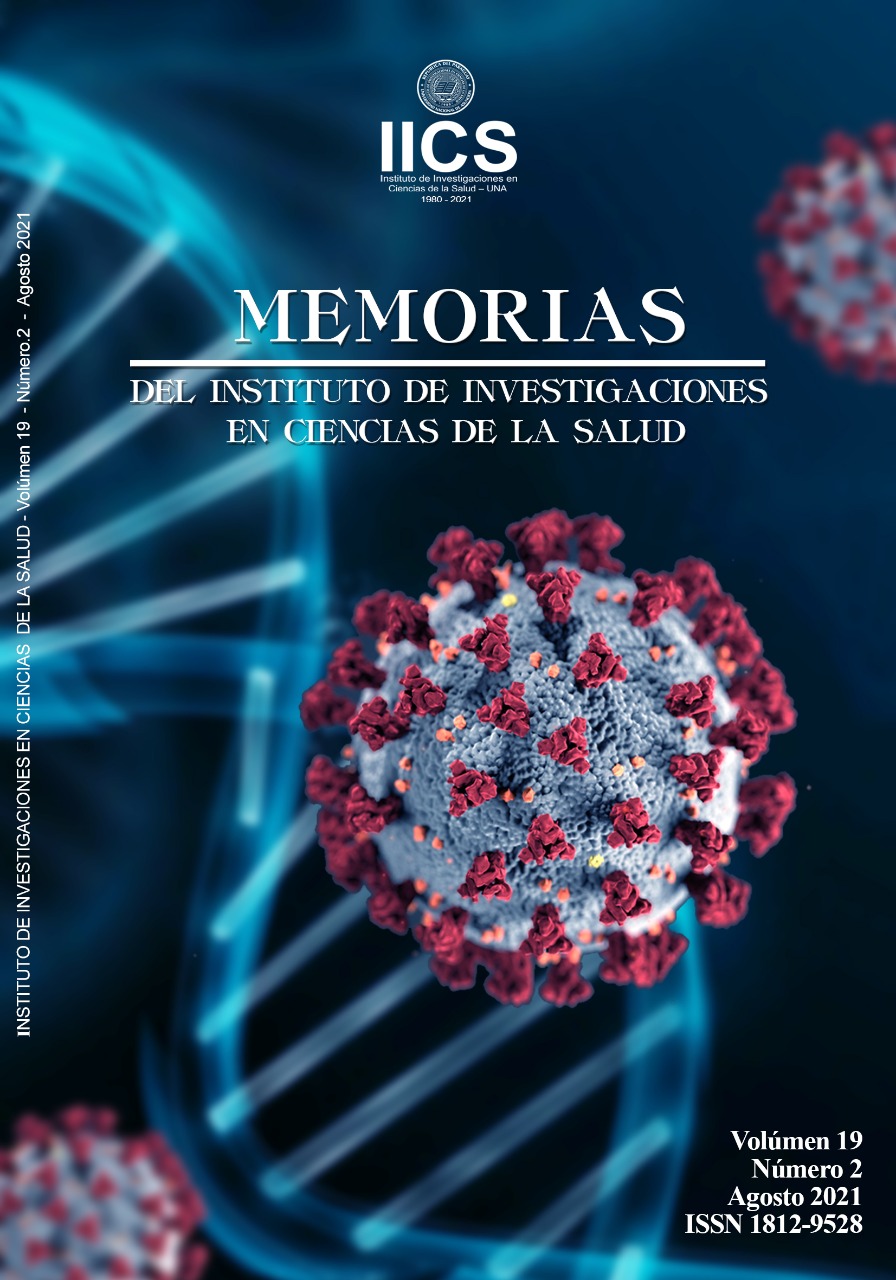Detección de papilomavirus humano en mucosa oral en hombres con verrugas anogenitales
DOI:
https://doi.org/10.18004/mem.iics/1812-9528/2021.019.02.41Palabras clave:
HPV, hombres, verrugas anogenitales, mucosa oralResumen
El virus del papiloma humano (HPV) es el agente etiológico de infecciones de transmisión sexual relacionadas con procesos oncogénicos genitales y orales. La biología molecular, mediante la identificación de los tipos virales involucrados, proporciona precisión diagnóstica con un enfoque epidemiológico. El objetivo de este estudio fue determinar la presencia de HPV en la mucosa oral de hombres con verrugas anogenitales y correlacionar los genotipos detectados en ambas muestras. Se estudiaron 26 pacientes varones con verrugas anogenitales que acudieron al Instituto de Dermatología de la ciudad de Resistencia (Argentina). La presencia de HPV en muestras orales y anogenitales se estudió mediante reacción en cadena de la polimerasa (PCR) y la genotipificación se realizó mediante PCR-RFLP. La prevalencia de HPV oral en pacientes con HPV anogenital fue del 46,2% (12/26). Se encontraron dieciocho genotipos con alto riesgo oncogénico en muestras orales de pacientes con infecciones únicas o múltiples y el tipo 16 fue el más frecuente (6 pacientes). Catorce genotipos en muestras orales fueron de bajo riesgo oncogénico, el más frecuente fue el tipo 6 (10 pacientes). En muestras anogenitales el genotipo 6 fue el más frecuente (13 pacientes), solo o en coinfección. Se encontró una alta prevalencia de HPV oral de malignidad de alto grado en nuestra población y coinfección con tipos oncogénicos. Las prácticas de sexo oral fueron la principal conducta de riesgo para la infección, lo que quedó demostrado por el hallazgo simultáneo del mismo tipo de HPV en muestras orales y anogenitales.
Descargas
Citas
De Villiers EM, Fauquet C, Broker TR, Bernard HU, Zur Hausen H. Classification of papillomaviruses. Virology. 2004; 324(1): 17-27.
Parkin DM. The global health burden of infection-associated cancers in the year 2002. Int J Cancer. 2006; 118(12): 3030-44.
Muñoz N, Bosch FX, de Sanjosé S, Herrero R, Castellsagué X, Shah K V., et al. Epidemiologic Classification of Human Papillomavirus Types Associated with Cervical Cancer. N Engl J Med. 2003; 348(6):518-27.
Walczak I, Dutkiewicz S, Majewski S, Jablonska S, Witeska A. Diagnosis of Human Papillomavirus (HPV): infection of male genital skin and mucosa. Urology. 2008; 72(5):S34.
Van Oijen MGCT, Leppers Vd Straat FGJ, Tilanus MGJ, Slootweg PJ. The origins of multiple squamous cell carcinomas in the aerodigestive tract. Cancer. 2000; 88(4): 884-93.
Zeuss MS, Miller CS, White DK. In situ hybridization analysis of human papillomavirus DNA in oral mucosal lesions. Oral Surgery, Oral Med Oral Pathol. 1991; 71(6):714-20.
Sugiyama M, Bhawal UK, Dohmen T, Ono S, Miyauchi M, Ishikawa T. Detection of human papillomavirus-16 and HPV-18 DNA in normal, dysplastic, and malignant oral epithelium. Oral Surg Oral Med Oral Pathol Oral Radiol Endod. 2003; 95(5): 594-600.
de Villiers EM. Heterogeneity of the human papillomavirus group. J Virol. 1989; 63(11):4898-903.
Frazer IH, Cox JT, Mayeaux EJ, Franco EL, Moscicki AB, Palefsky JM, et al. Advances in prevention of cervical cancer and other human papillomavirus-related diseases. Pediatr Infect Dis J. 2006; 25(2 SUPPL.): 65-81.
Silva R, León D, Brebi P, Ili C, Roa JC, Sánchez R. Detection of human papilloma virus infection in men. Rev Chil infectología. 2013; 30(2):186-92.
Bernard HU, Chan SY, Manos MM, Ong CK, Villa LL, Delius H, et al. Identification and assessment of known and novel human papillomaviruses by polymerase chain reaction amplification, restriction fragment length polymorphisms, nucleotide sequence, and phylogenetic algorithms. J Infect Dis. 1994; 170(5):1077-85.
Wheeler C, Yamada T. Human papillomavirus type 16 sequence variants: identification by E6 and L1 Human Papillomavirus Type 16 Sequence Variants : Identification by E6 and L1. J Clin Microbiol. 1997; 35(1):11-9.
Molijn A, Kleter B, Quint W, Van Doorn LJ. Molecular diagnosis of human papillomavirus (HPV) infections. J Clin Virol. 2005; 32(SUPPL.):43-51.
Mandelblatt JS, Lawrence WF, Womack SM, Jacobson D, Yi B, Hwang YT, et al. Benefits and costs of using HPV testing to screen for cervical cancer. J Am Med Assoc. 2002; 287(18):2372-81.
Medina MG, Marinic K, Motta P, Sorrentino A, Giménez MF. Detección y genotipificación de papilomavirus humano en hombres. Piel. 2010;25(10):561-4.
Partridge JM, Koutsky LA. Genital human papillomavirus infection in men. Lancet Infect Dis. 2006; 6(1):21-31.
Freire MP, Pires D, Forjaz R, Sato S, Cotrim I, Stiepcich M, et al. Genital prevalence of HPV types and co-infection in men. Int Braz J Urol. 2014; 40(1):67-71.
Hernandez-Suarez G, Pineros M, Vargas JC, Orjuela L, Hernandez F, Peroza C, et al. Human papillomavirus genotypes in genital warts in Latin America: A cross-sectional study in Bogota, Colombia. Int J STD AIDS. 2013; 24(7):567-72.
Cavazza Porro M, Avila M, Correnti M, Vasquez W, López Y. Human Papillomavirus in Venezuelan patients with condylomata acuminata. In: 24th International Papillomavirus Conference and Clinical Workshop [Internet]. Beijin: International Papillomavirus Society; 2007. p. PS12-04. Available from: http://af.global.cnki.net/stmt/TitleBrowse/KnowledgeNet/ZHYX200711005462?db=STMI8320
Stewart B, Kleihues P, editors. World Cancer Report. WHO Chronicle. Lyon: IARC Press; 2003. 323-326 p.
Lipsky MS, Su S, Crespo CJ, Hung M. Men and Oral Health: A Review of Sex and Gender Differences. Am J Mens Health. 2021; 15 (3).
Kreimer AR, Clifford GM, Boyle P, Franceschi S. Human papillomavirus types in head and neck squamous cell carcinomas worldwide: A systemic review. Cancer Epidemiol Biomarkers Prev. 2005; 14(2):467-75.
Herrero R, Castellsagué X, Pawlita M, Lissowska J, Kee F, Balaram P, et al. Human papillomavirus and oral cancer: The international agency for research on cancer multicenter study. J Natl CancerInst. 2003;95(23):1772-83.
Schiffman MH, Bauer HM, Hoover RN, Glass AG, Cadell DM, Rush BB, et al. Epidemiologic evidence showing that Human Papillomavirus infection causes most cervical intraepithelial neoplasia. J Natl Cancer Inst. 1993 Jun 16;85(12):958-64.
Bianco M, Correa C. La adolescencia en Argentina: sexualidad y pobreza [Internet]. CABA; 2003. Available from: http://feim.org.ar/2003/06/14/la-adolescencia-en-argentina-sexualidad-y-pobreza/
Nyitray AG, Carvalho Da Silva RJ, Baggio ML, Lu B, Smith D, Abrahamsen M, et al. Age-specific prevalence of and risk factors for anal human papillomavirus (HPV) among men who have sex with women and men who have sex with men: The HPV in men (HIM) study. J Infect Dis. 2011; 203(1):49-57.
Quinn R, Salvatierra J, Solari V, Calderon M, Ton TGN, Zunt JR. Human papillomavirus infection in men who have sex with men in Lima, Peru. AIDS Res Hum Retroviruses. 2012; 28(12):1734-8.
González JV, Deluca GD, Liotta DJ, Correa RM, Basiletti JA, Colucci MC, et al. Baseline prevalence and type distribution of Human papillomavirus in sexually active non-vaccinated adolescent girls from Argentina. Rev Argent Microbiol. 2021; 53 (1): 11-9.
Aranda CE. Infección por el virus del papiloma humano en varones. Ginecol Obstet Mex. 2015; 83(11):697-706.
Morelatto RA, Lopez De Blanc SA. Oral cancer mortality in the province of Cordoba, Argentine Republic (period 1975-2000). A comparative study with other populations. Med Oral Patol Oral Cir Bucal. 2006; 11(3):144-9.














